Landscape Education Two Decades after the European Landscape Convention—A Study with Trainee Teachers
Abstract
1. Introduction
1.1. Education about Landscape
1.2. Landscape Education in the European Landscape Convention (ELC)
- (A)
- Awareness-raising. Each Party undertakes to increase awareness among the civil society, private organisations, and public authorities of the value of landscapes, their role and changes to them.
- (B)
- Training and education. Each Party undertakes to promote (a) training for specialists in landscape appraisal and operations; (b) multidisciplinary training programmes in landscape policy, protection, management, and planning, for professionals in the private and public sectors and for associations concerned; (c) school and university courses which, in the relevant subject areas, address the values attached to landscapes and the issues raised by their protection, management, and planning [11].
1.3. Aim of This Study
- Exploring the possible influence of socio-educational factors (based on personal data) on the participants’ perception of landscape.
- Determining scientific and institutional understanding of landscape (objective dimension).
- Establishing the landscape education received during the participants’ pre-university education (curricula).
- Establishing the participants’ critical personal relationship with landscape (self-reflection on subjective dimensions and ethical implications).
2. Materials and Methods
2.1. Data Collection and Study Sample
2.2. Research Variables and Statistical Analysis of the Data
3. Results
3.1. Scientific and Institutional Knowledge of Landscape
3.2. Perception of Pre-University Landscape Education
3.3. Critical Reflection on Landscape
3.4. Socio-Educational Factors That May Have an Effect on the Perception of Landscape
4. Discussion and Conclusions
- -
- Improving the education about landscape of teachers (for instance, by including this specific topic in the curriculum of the didactics of geography, like with other lateral issues, such as gender perspectives and education in sustainability) following the principles of geographical education for sustainable development (ESD) [39]. It should be also of great convenience to promote landscape education in other fields to cover some landscape dimensions beyond the geographical perspective, such as literary narratives [40,41], mathematical spatial properties [42,43], physical education outdoors [44], history sceneries [30], artistic expression [45,46], and more. Natural sciences is another field that considers landscape training [47], although just from a natural perspective. In fact, in order to avoid bias, it could be even positive to include a specific subject of landscape education [35]. This is due to the cross-cutting nature of the concept and its relevance in the context of ESD, which is key in primary education. The unequal knowledge of future teachers will project significant asymmetries onto the conceptualisation and valorisation of landscape in future generations.
- -
- Promoting a more practical education (active methodologies) over the theoretical and passive methods reflected in our study. There is much room for improvement in terms of didactics of landscape, as already argued by the ELC. Education should encourage the reading of landscape and a better understanding of the relationship between everyday life and landscape, which in turn will clarify the relationship between ecology and landscape and even between social and economic factors; these are complex issues that demand practical and interactive resources, materials, and methodologies [48,49,50,51].
- -
- Encouraging the use of landscape in the classroom at various levels. Landscape should be understood as both a subject of study and a teaching tool. Educating with landscape significantly contributes to educating about landscape. This study shows that landscape education in Spain is approached from a largely theoretical perspective. But landscapes are a complex convergence of elements and interactions that is difficult to teach in this way. Their use as a didactic tool, especially using practical methodologies that can help to appreciate this convergence palpably, rather than abstractly, would help with a better understanding of this complexity. Study trips, simulations, recreations, GIS-based analysis, and landscape commentary are highly promising methods in this regard [52,53,54,55].
Author Contributions
Funding
Institutional Review Board Statement
Informed Consent Statement
Data Availability Statement
Acknowledgments
Conflicts of Interest
Appendix A. Questionnaire Model Given to the Students [In Spanish]
- Estimado estudiante:
- Desde el grupo de investigación GEODIDAC, de la Universidad Complutense de Madrid, estamos realizando un estudio sobre la educación en paisaje desde la firma del Convenio Europeo del Paisaje. Nos gustaría conocer cuál es la concepción del paisaje del futuro profesorado. Por eso te pedimos si, por favor, podrías cumplimentar el siguiente cuestionario, con sinceridad y con la tranquilidad de no ser evaluado.
- Con tu cumplimentación aceptas el tratamiento de los datos proporcionados, que usaremos para nuestra investigación siguiendo las Orientaciones Éticas para la Investigación Social Comparativa Internacional del código ético de investigación en Ciencias Sociales dictado por la UNESCO, a destacar, el anonimato en la recogida de datos, la garantía del consentimiento informado y el respeto a la confidencialidad en la publicación de la investigación.
- Muchas gracias por tu colaboración.
| 1 | Estudios/curso | |||
| 2 | Edad | |||
| 3 | Lugar de residencia | |||
| 4 | Lugar de nacimiento | |||
| 5 | Sexo | Mujer | Hombre | |
| 6 | Opción cursada en Bachillerato | Artes | Ciencias | Ciencias Sociales y Humanidades |
| 7 | ¿Elegiste Geografía como asignatura optativa en Bachillerato? | Si | No | |
| 8 | Define brevemente el concepto paisaje | |||
| 9 | ¿Son lo mismo paisaje y territorio? | |||
| 10 | ¿Recuerdas haber estudiado el paisaje en la ESO? | SI | NO | |
| 11 | ¿Cómo se impartió este tema (ESO)? | |||
| 12 | ¿Recuerdas haber estudiado el paisaje en Bachillerato? | SI | NO | |
| 13 | ¿Cómo se impartió este tema (Bachillerato)? | |||
| 14 | ¿Vives en un paisaje? | SI | NO | |
| 15 | ¿Te consideras un agente con capacidad de intervención en la toma de decisiones que pueden afectar al paisaje? | SI | NO | |
| 16 | ¿Piensas que el paisaje es un elemento de tu calidad de vida?¿Por qué? | |||
| 17 | ¿Sabes lo que es el Convenio Europeo del Paisaje? | |||
| 18 | ¿Sabes si España ratificó este convenio? | SI | NO | |
| 19 | ¿Sabes si existen leyes del paisaje? | SI | NO | |
| 20 | ¿Sabes si existen paisajes protegidos? ¿Conoces alguno? | |||
Appendix B. Inferential Statistical Data and Data Matrix
- All the results from the inferential statistical tests and the data matrix itself are compiled in the following zip file, hosted in an institutional open-access repository: https://www.ucm.es/carlos-martinez-hernandez/file/appendix2-statistical-data
- The file contains 7 text documents in Spanish as follows:
- “spss_chi_edad”: Tests for the independent variable “Age”.
- “spss_chi_grupo”: Tests for the independent variable “Degree”.
- “spss_chi_nacimiento”: Tests for the independent variable “Born place”.
- “spss_chi_optativa”: Tests for the independent variable “Geo as optional”.
- “spss_chi_residencia”: Tests for the independent variable “Living place”.
- “spss_chi_resi-naci”: Tests for the independent variable “Housing trajectory”.
- “spss_chi_sexo”: Tests for the independent variable “Sex”.
- The file also contains 1 spreadsheet document in Spanish:
- “Data_matrix”: Data matrix used as a result of the responses to the questionnaire and the adaptation to the research variables.
References
- Crespo, J.M. Paisaje, un concepto geográfico para la educación ecosocial. Con-Cienc. Soc. (Segunda Época) 2020, 4, 59–72. [Google Scholar] [CrossRef]
- Crutzen, P.J.; Stoermer, E.F. The Anthropocene. Glob. Chang. Newsl. 2000, 41, 17–18. [Google Scholar] [CrossRef]
- Duarte, C. (coord.); Cambio Global. Impacto de la Actividad Humana Sobre el Sistema Tierra; CSIC: Madrid, Spain, 2006; Available online: http://aeclim.org/wp-content/uploads/2016/01/Cambio_global.pdf (accessed on 23 September 2023).
- Zabala, G.H.; García, M. Historia de la Educación Ambiental desde su discusión y análisis en los congresos internacionales. Rev. Investig. 2008, 63, 201–218. Available online: http://ve.scielo.org/scielo.php?script=sci_arttext&pid=S1010-29142008000100011&lng=es&nrm=iso (accessed on 23 September 2023).
- Brundtland, G.H. (Ed.) Our Common Future; Oxford University Press: Oxford, UK, 1987. [Google Scholar]
- Zoido, F. De la Carta de Sevilla al Convenio de Florencia. Patrim. Cult. España 2021, 12, 39–56. [Google Scholar]
- Castiglioni, B. Education on Landscape for Children; Council of Europe: Strasbourg, France, 2009. [Google Scholar]
- Busquets, J. La Educación en paisaje: Una oportunidad para la escuela. El paisaje en la educación. Íber Didáctica De Las Cienc. Soc. Geogr. E Hist. 2010, 65, 7–16. [Google Scholar]
- Del Pozo, M. Paisaje, ciudadanía y educación. In Paisaje i Educación; Nogué, J., Puigbert, L., Bretcha, G., Losantos, A., Eds.; Observatori del Paisatge de Catalunya: Barcelona, Spain, 2011; pp. 374–376. [Google Scholar]
- Castiglioni, B. Education on landscape: Theoretical and practical approaches in the frame of the European Landscape Con-vention. In Geographical Views on Education for Sustainable Development; IGU: Lucerne-Symposium, Switzerland, 2007. [Google Scholar]
- Council of Europe. European Landscape Convention; Council of Europe: Florence, Italy, 2000. [Google Scholar]
- Zoido, F. La aplicación del Convenio Europeo del Paisaje en España. In Convenio Europeo del Paisaje, Textos y Comentarios; Cortina, A., Queralt, A., Eds.; Ministerio de Medio Ambiente: Madrid, Spain, 2007. [Google Scholar]
- Fernández, R.; Plaza, J.I. Participación ciudadana y educación en materia de paisaje en el marco del Convenio Europeo del Paisaje en España. Cuad. Geográf. 2019, 58, 262–286. [Google Scholar] [CrossRef]
- Martínez Medina, R. La enseñanza del paisaje en España. Una mirada a través de los manuales escolares de Ciencias Sociales. Rev. Contexto Educ. 2017, 31, 9–33. [Google Scholar] [CrossRef][Green Version]
- Crespo, J.M. La Educación en Paisaje en el Grado de Maestro de Educación Primaria: Una Propuesta de Modelo Didáctico. Doctoral Thesis, Universidad Complutense de Madrid, Madrid, Spain, 2018. Available online: https://hdl.handle.net/20.500.14352/16281 (accessed on 23 September 2023).
- Casas, M.; Erneta, L. El paisaje en la Enseñanza Secundaria Obligatoria. Una oportunidad educativa en el cambio curricular LOE-LOMCE. Didáct. Geográf. 2016, 16, 45–71. Available online: https://didacticageografica.age-geografia.es/index.php/didacticageografica/article/view/295 (accessed on 23 September 2023).
- Casas, M.; Puig, J.; Erneta, L. El paisaje en el contexto curricular de la LOMCE: Una oportunidad educativa, ¿aprovechada o desaprovechada? Didáct. Geográf. 2018, 18, 39–68. Available online: https://didacticageografica.age-geografia.es/index.php/didacticageografica/article/view/382 (accessed on 23 September 2023).
- Casas, M.; Puig, J.; Erneta, L. El estudio del paisaje en la Educación Secundaria Obligatoria: Una mirada desde los libros de texto de Ciencias Sociales. Rev. UNES Univ. Esc. Y Soc. 2019, 6, 56–75. Available online: https://revistaseug.ugr.es/index.php/revistaunes/article/view/12120 (accessed on 23 September 2023).
- Bajo, M.J. El paisaje en el curriculum de Educación Primaria, dentro del área del conocimiento del medio natural, social y cultural. Aula 2009, 13, 41–74. [Google Scholar]
- Fernández, R.; Fernández, J. Design and Initial Validation of a Questionnaire on Prospective Teachers’ Perceptions of the Landscape. Educ. Sci. 2021, 11, 112. [Google Scholar] [CrossRef]
- Delgado, E. El paisaje en la formación de maestros, un recurso educativo de alto interés para la Educación Primaria. Tabanque Rev. Pedagog. 2015, 28, 117–138. [Google Scholar]
- Mateo, M.R. Las concepciones sobre el paisaje en la formación inicial del profesorado. Didáct. Geográf. 2020, 21, 41–74. [Google Scholar] [CrossRef]
- Bajo, M.J.; Fernández, R. El paisaje en la formación inicial de maestros: Un estudio de caso con métodos mixtos. Rev. De Investig. En Didáct. De Las Cienc. Soc. 2022, 10, 96–121. [Google Scholar] [CrossRef]
- Fernández, J.; García, L. La percepción del paisaje de Castilla y León en los estudiantes del Grado de Educación. In Análisis Espacial y Representación Geográfica: Innovación y Aplicación; De la Riva, J., Ibarra, P., Montorio, R., Rodrigues, M., Eds.; Universidad de Zaragoza: Zaragoza, Spain, 2015; pp. 1357–1366. [Google Scholar]
- Torrado, M. Estudios de Encuesta. Metodología de la Investigación Educativa, 2nd ed.; Muralla, L., Ed.; Universidad Oberta de Catalunya: Barcelona, Spain, 2009; pp. 231–257. [Google Scholar]
- Barlett, J.E.; Kotrlik, J.W.; Higgins, C.C. Organizational research: Determining appropriate sample size in survey research. Inf. Technol. Learn. Perform. J. 2001, 19, 43–50. [Google Scholar]
- Martínez, C.; Robles-Moral, F.J. Cuestionario sobre Educación Ambiental valorada a través del Análisis del Paisaje (CEAVAP). Diseño y validación con maestros en formación de España y Colombia. In Igualdad y Calidad Educativa: Oportunidades y Desafíos de la Enseñanza; Vico, A., Vega, L., Eds.; Dykinson: Madrid, Spain, 2021; pp. 1434–1454. [Google Scholar]
- Cohen, L.; Manion, L.; Morrison, K. Research Methods in Education, 8th ed.; Routledge: London, UK, 2018. [Google Scholar]
- Yaghmaie, F. Content validity and its estimation. J. Med. Educ. 2003, 3, e105015. [Google Scholar] [CrossRef]
- Gómez-Zotano, J.; Riesco-Chueca, P. Landscape learning and teaching: Innovations in the context of European landscape Convention. In Proceedings of the 4th International. Technology, Education and Development Conference, Valencia, Spain, 8–10 March 2010. [Google Scholar]
- García de la Vega, A. El paisaje y la Educación Ambiental. Contexto Educ. 2016, 31, 3–8. [Google Scholar] [CrossRef][Green Version]
- Martínez de Pisón, E. Paisaje, cultura y territorio. In La Construcción Social del Paisaje; Nogué, J., Ed.; Biblioteca Nueva: Madrid, Spain, 2016; pp. 325–337. [Google Scholar]
- Gómez, I.M.; Yáñez, C. El aprendizaje del espacio en didáctica de la Geografía: Recursos tecnológicos y TPACK para adquirir la competencia espacial. Didáct. Geográf. 2022, 23, 103–123. [Google Scholar] [CrossRef]
- Martínez-Medina, R.; Ávila-Marín, C. La noción del paisaje en el alumnado de Educación Primaria: Un análisis de su representación. Doc. D’anàlisi Geogràf. 2021, 67, 133–151. [Google Scholar] [CrossRef]
- Rodríguez, F.; Riveiro, T.; Armas, F. From the study of landscape to landscape education: Research and teacher training for primary education (6–12 years). Agua Y Territ./Water Landsc. 2022, 23, e7200. [Google Scholar] [CrossRef]
- De Miguel, R. Del pensamiento espacial al conocimiento geográfico a través del aprendizaje activo con tecnologías de la información geográfica. Giramundo 2015, 2, 7–13. [Google Scholar]
- Martínez de Pisón, E. Saber ver el paisaje. Estud. Geográf. 2010, 71, 395–414. [Google Scholar] [CrossRef]
- Marcén, A.C.; Benayas del Álamo, J. Aproximación cualitativa a la incorporación del “paisaje” en la nueva Ley Orgánica de Educación de Enseñanzas No Universitarias (LOMLOE). Rev. Ecosist. 2023, 32, 2556. [Google Scholar] [CrossRef]
- Martínez-Hernández, C.; Mínguez, C. The Anthropocene and the sustainable development goals: Key elements in geography higher education? Int. J. Sustain. High. Educ. 2023, 24, 1648–1667. [Google Scholar] [CrossRef]
- Ilgenfritz Toso, C.E.; De Moraes, M.M.; Copetti Callai, H. Ensinar geografia com literatura. In La Investigación e Innovación en la Enseñanza de la Geografía; Rafael, S.A., Monllor, T., María, E., Eds.; Universidad de Alicante: San Vicente del Raspeig, Spain, 2016; pp. 749–758. [Google Scholar]
- García de la Vega, A. El desarrollo curricular del paisaje a través de las áreas instrumentales. In CiDd: II Congrés Internacional de Didàctiques; Universidad de Girona: Girona, Spain, 2010; Available online: http://www2.udg.edu/portals/3/didactiques2010/guiacdii/ACABADES%20FINALS/373.pdf (accessed on 23 September 2023).
- Ruiz, N.; Garrido, R. Recorridos matemáticos por la ciudad. In Didácticas Específicas Aplicadas a Través del Patrimonio Local; Pastor, M.M., Santisteban, A., Eds.; Paraninfo: Madrid, Spain, 2020; pp. 461–480. [Google Scholar]
- Akinci, A.; Akinci, C. The Importance of Spatial Ability Research: The Case of Landscape Architecture Education. In Environmental Sustainability and Landscape Management; Efe, R., Cürebal, I., Gad, A., Tóth, B., Eds.; St. Kliment Ohridski University Press: Sofia, Bulgaria, 2016; pp. 535–545. [Google Scholar]
- Cepollaro, G.; Zanon, B. The landscape as a learning space. The experiential approach of a ‘landscape school’ in Trentino, Italy. Landsc. Res. 2022, 47, 244–255. [Google Scholar] [CrossRef]
- Fox, A.; Macpherson, H.; Oli, N.; Ranjit, A.; Thapa, S.; Aggett, S.; Church, A. Mobile drawing methods in landscape research: Collaborative drawing in Kathmandu Valley, Nepal. Landsc. Res. 2022, 47, 1009–1023. [Google Scholar] [CrossRef]
- Fernández-Portela, J. La pintura como herramienta didáctica para explicar el paisaje agrario: El ejemplo del viñedo castellanoleonés desde mediados del siglo XX. In Nuevas Perspectivas Conceptuales y Metodológicas para la Educación Geográfica; Martínez, R., Tonda, E., Eds.; Universidad de Córdoba: Cordoba, Spain, 2014; pp. 153–164. [Google Scholar]
- Dale, R.; Powell, R.; Stern, M.; Garst, B. Influence of the natural setting on environmental education outcomes. Environ. Educ. Res. 2020, 26, 613–631. [Google Scholar] [CrossRef]
- Martínez-Hernández, C.; Cifo-Izquierdo, M.I.; Farinós-Celdrán, P.; Robles-Moral, F.J. Salida a un espacio natural para desarrollar competencias interdisciplinares de maestros en formación. Rev. Interuniv. De Form. Del Profesorado. Contin. De La Antig. Rev. De Esc. Norm. 2021, 96, 225–246. [Google Scholar] [CrossRef]
- Hurtado, A.; Botella, A.M.; Fernández, R.; Martínez, S. Development of Social and Environmental Competences of Teachers in Training Using Sound and Visual Landscape. Educ. Sci. 2023, 13, 593. [Google Scholar] [CrossRef]
- García de la Vega, A. Perspectivas de futuro en el aprendizaje del paisaje. Didáct. Geográf. 2019, 20, 55–77. [Google Scholar] [CrossRef]
- Domínguez, A.; López, R. Patrimonio, paisaje y educación: Formación inicial del profesorado y educación cívica del alumnado de primaria. CLIO Hist. Hist. Teach. 2014, 40, 1–26. [Google Scholar]
- Crespo, J.M. Un itinerario didáctico para la interpretación de los elementos físicos de los paisajes de la sierra de Guadarrama. Didáct. Geográf. 2012, 13, 15–34. Available online: https://didacticageografica.age-geografia.es/index.php/didacticageografica/article/view/94 (accessed on 23 September 2023).
- García de la Vega, A. La didáctica del paisaje a través de los itinerarios y la Cartografía. Didáct. Geográf. 2019, 20, 15–24. Available online: https://didacticageografica.age-geografia.es/index.php/didacticageografica/article/view/438 (accessed on 23 September 2023).
- Kerski, J.; Demirci, A.; Milson, A.J. The Global Landscape of GIS in Secondary Education. J. Geogr. 2013, 112, 232–247. [Google Scholar] [CrossRef]
- Jericó, M.; Erneta, L. Propuesta didáctica para la enseñanza del paisaje a través del empleo de la metodología Flipped Classroom. Publicaciones Didáct. 2017, 78, 448–498. [Google Scholar]
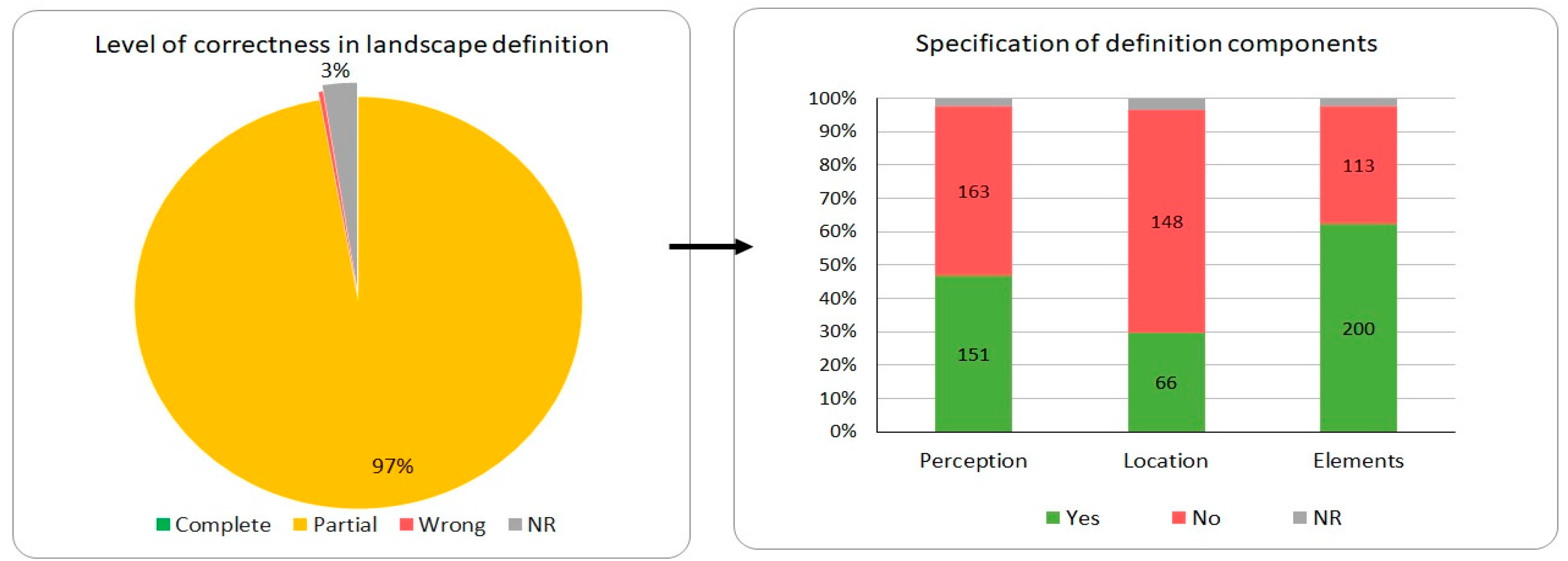
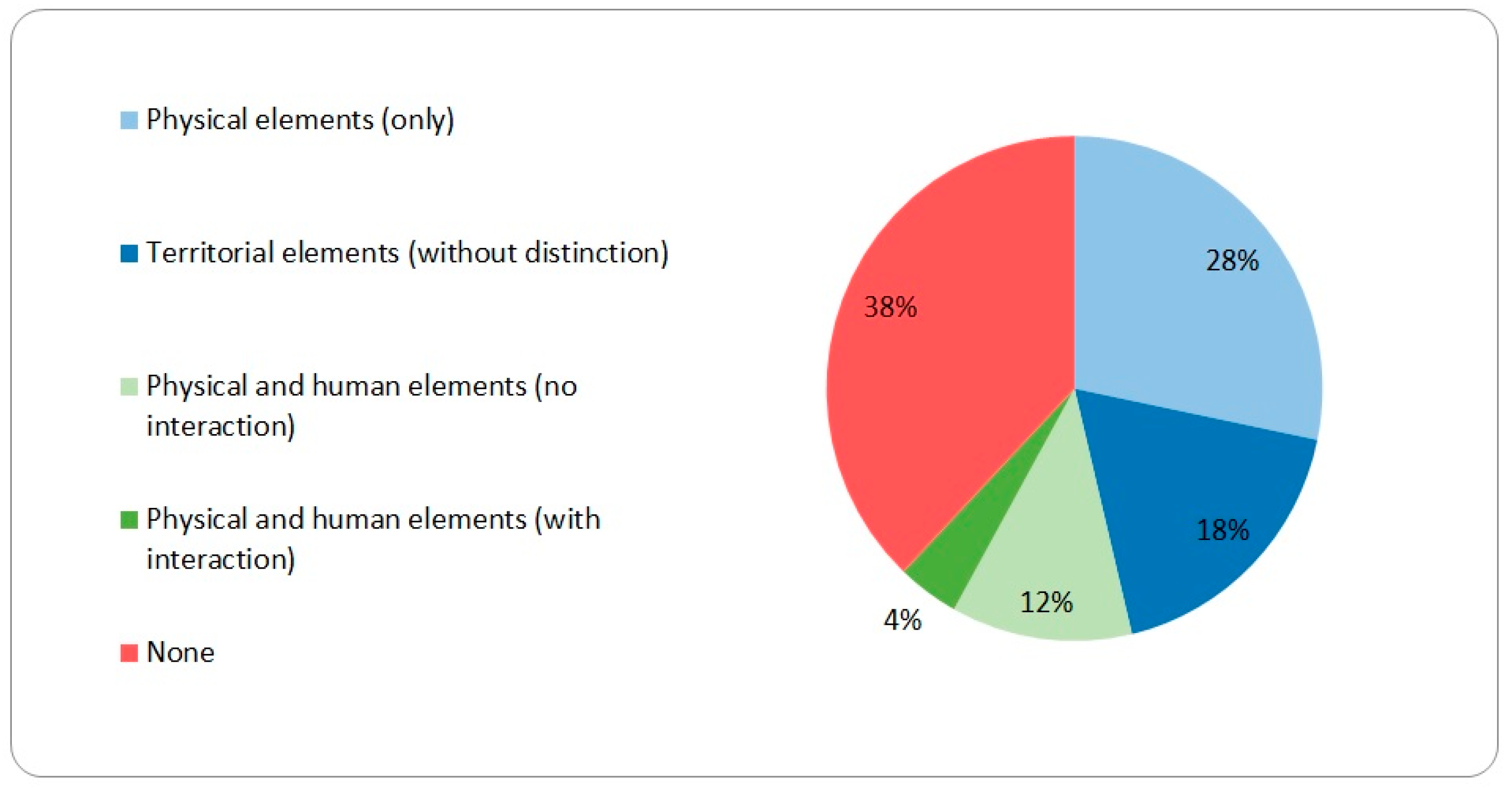
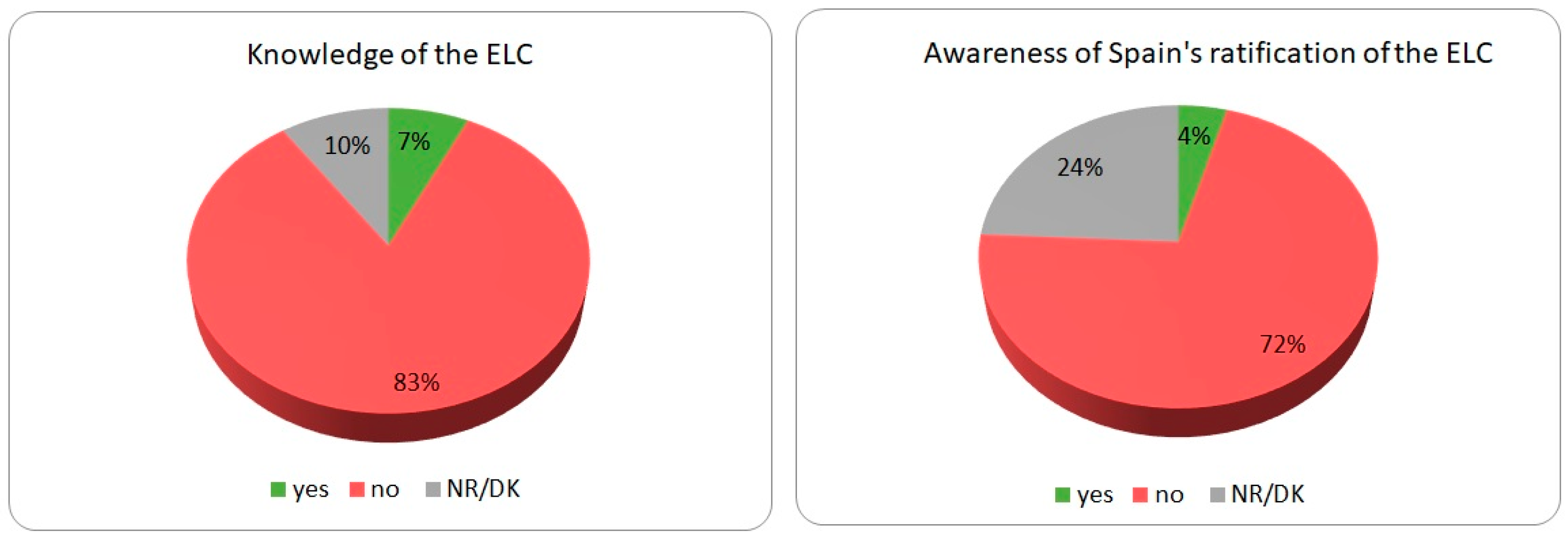
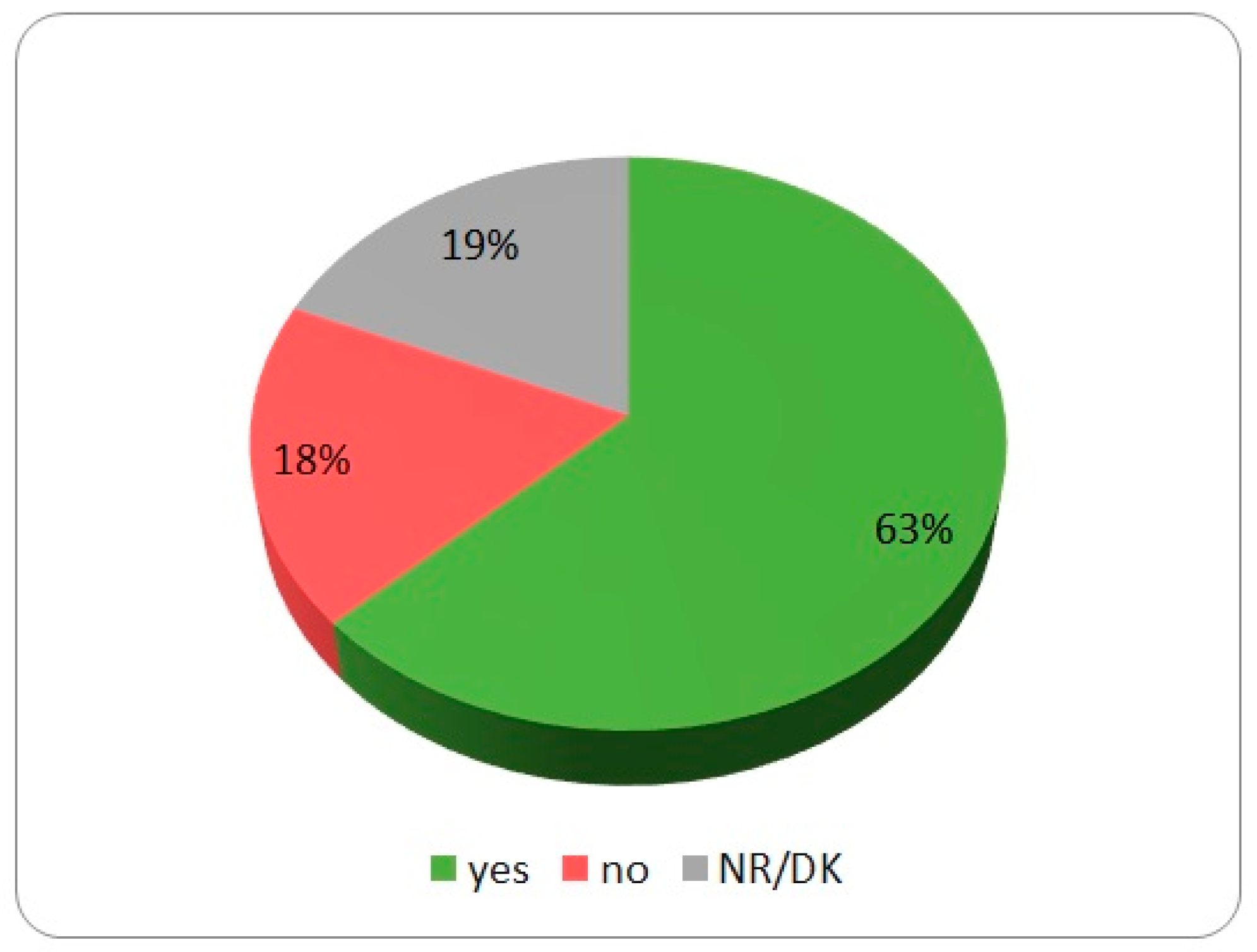


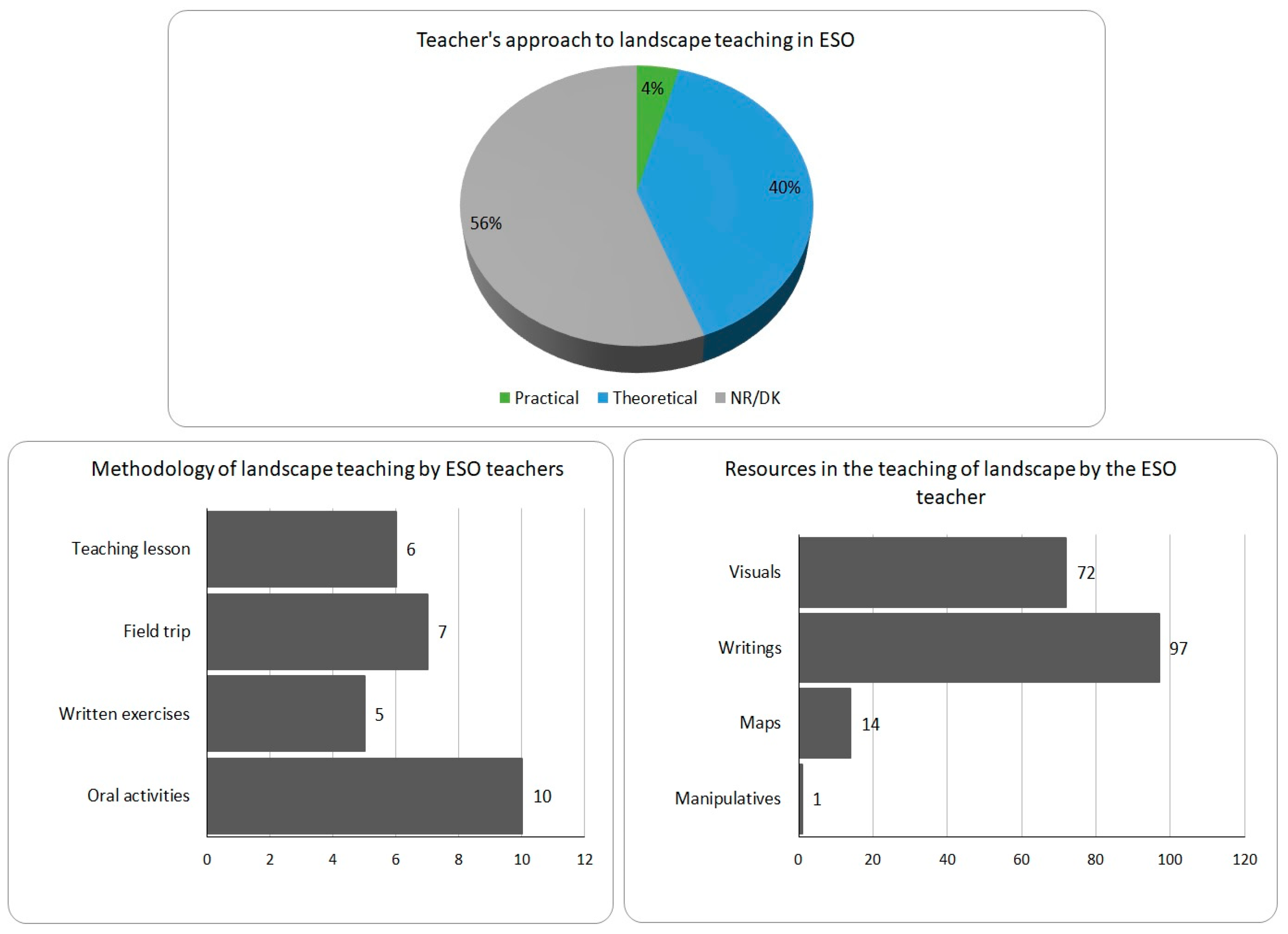
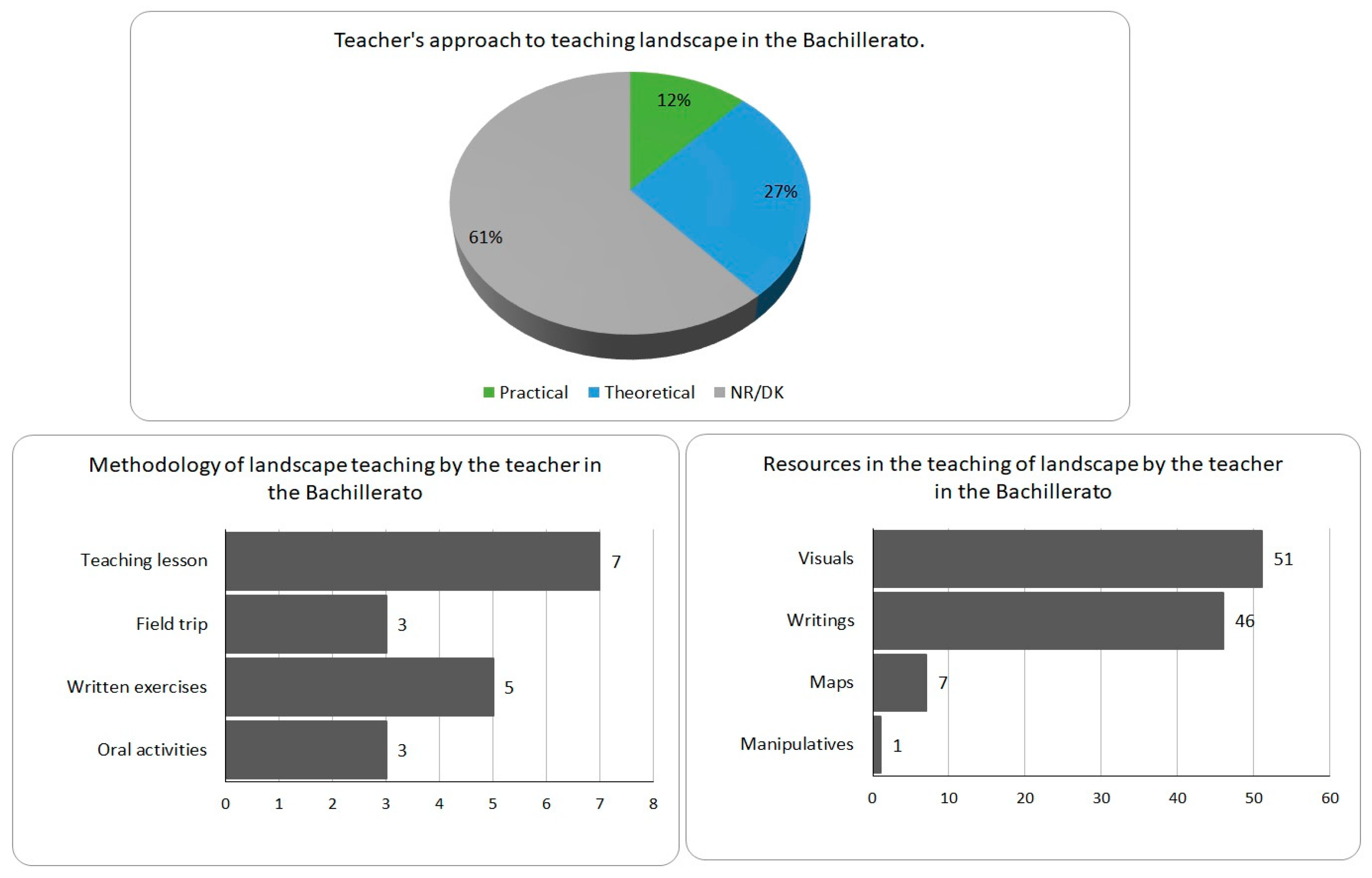
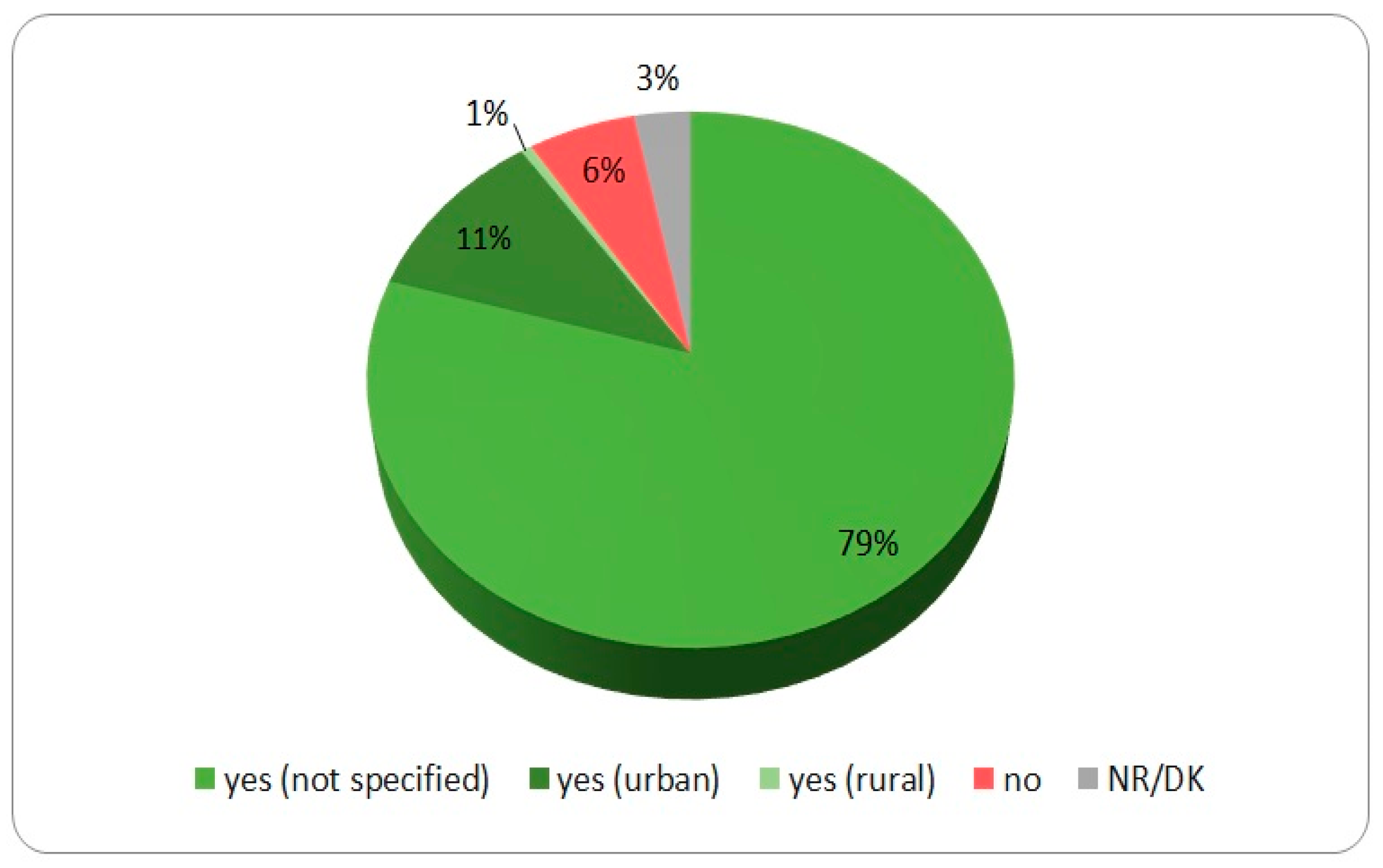
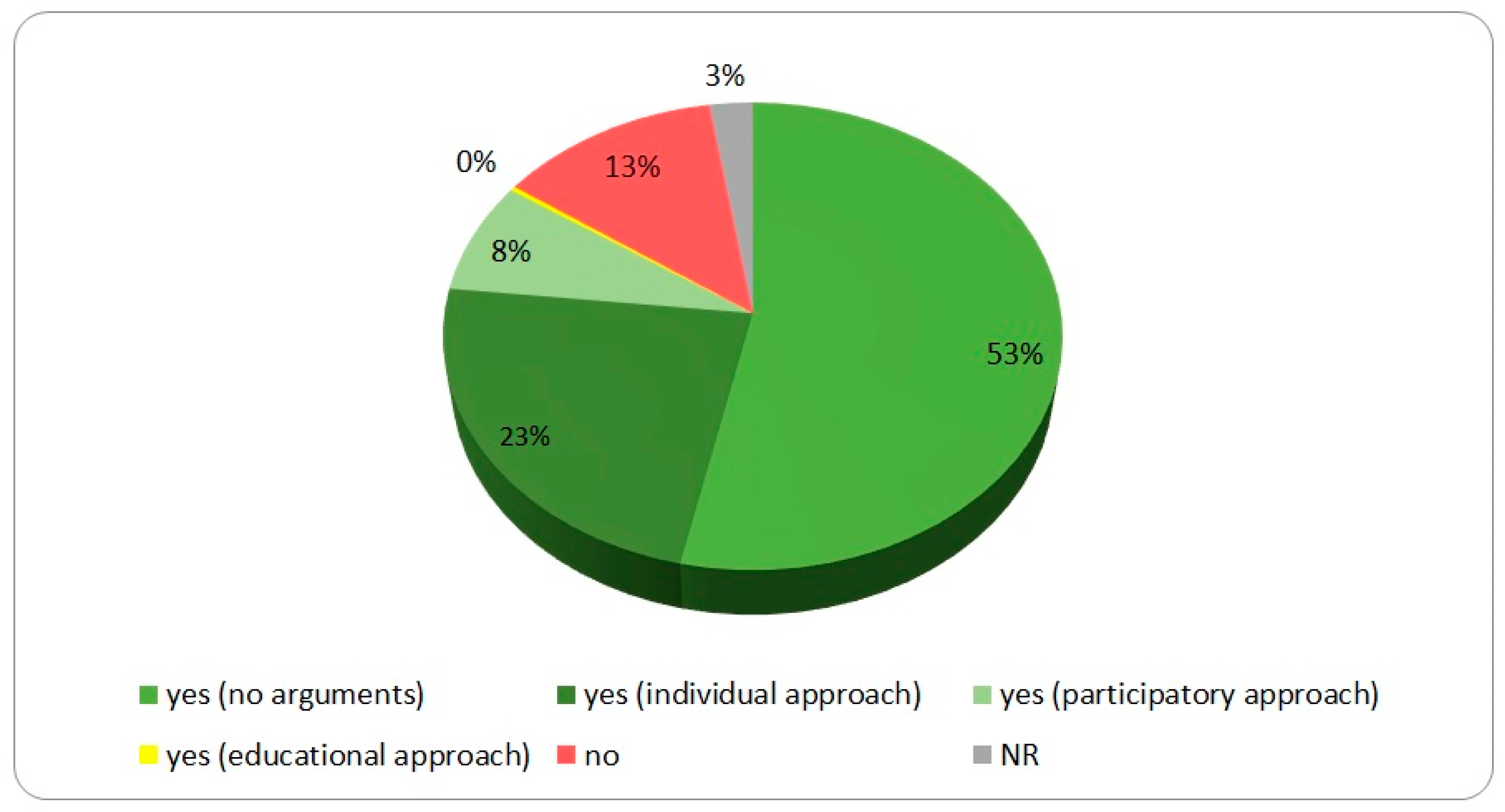
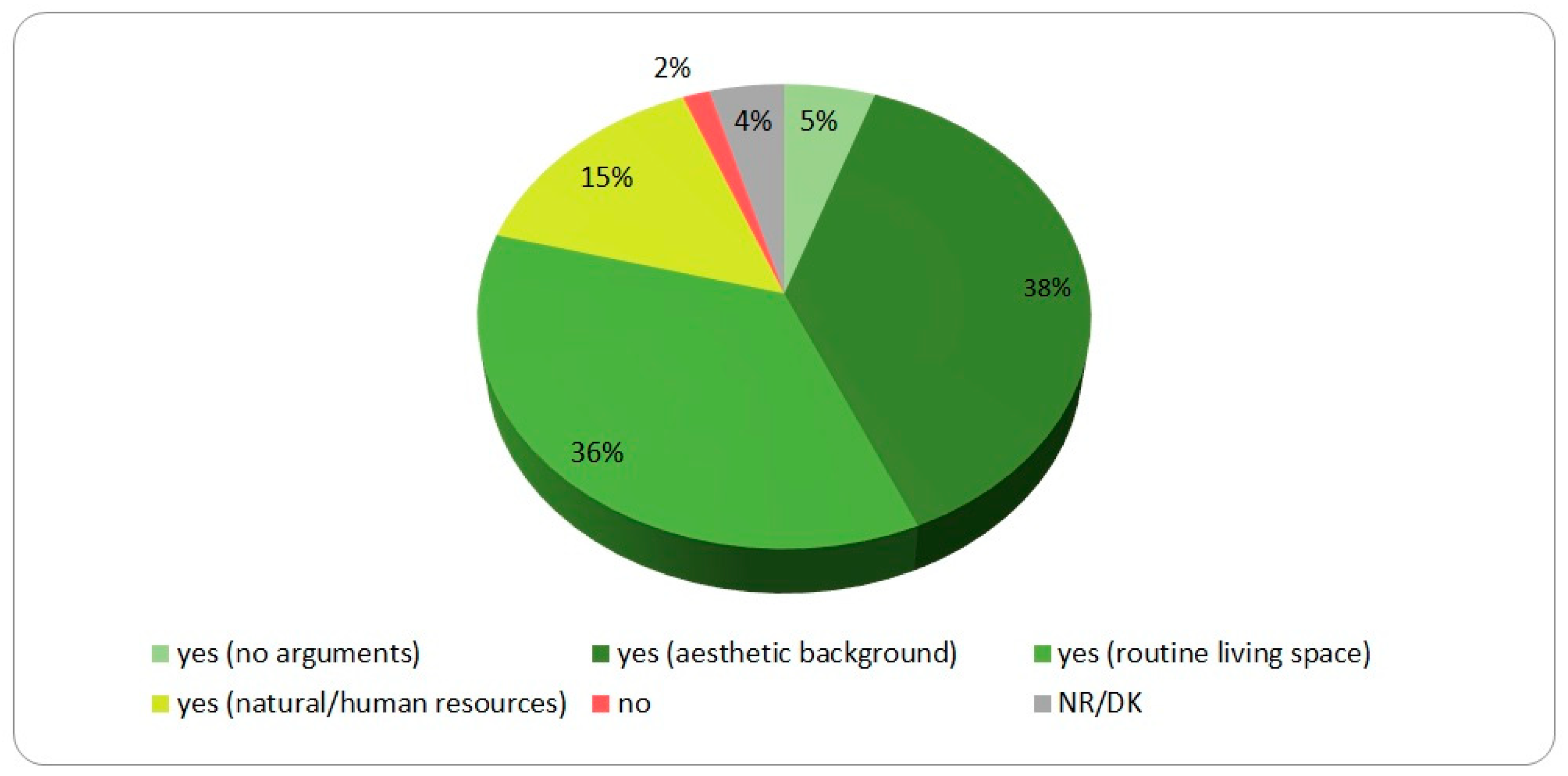
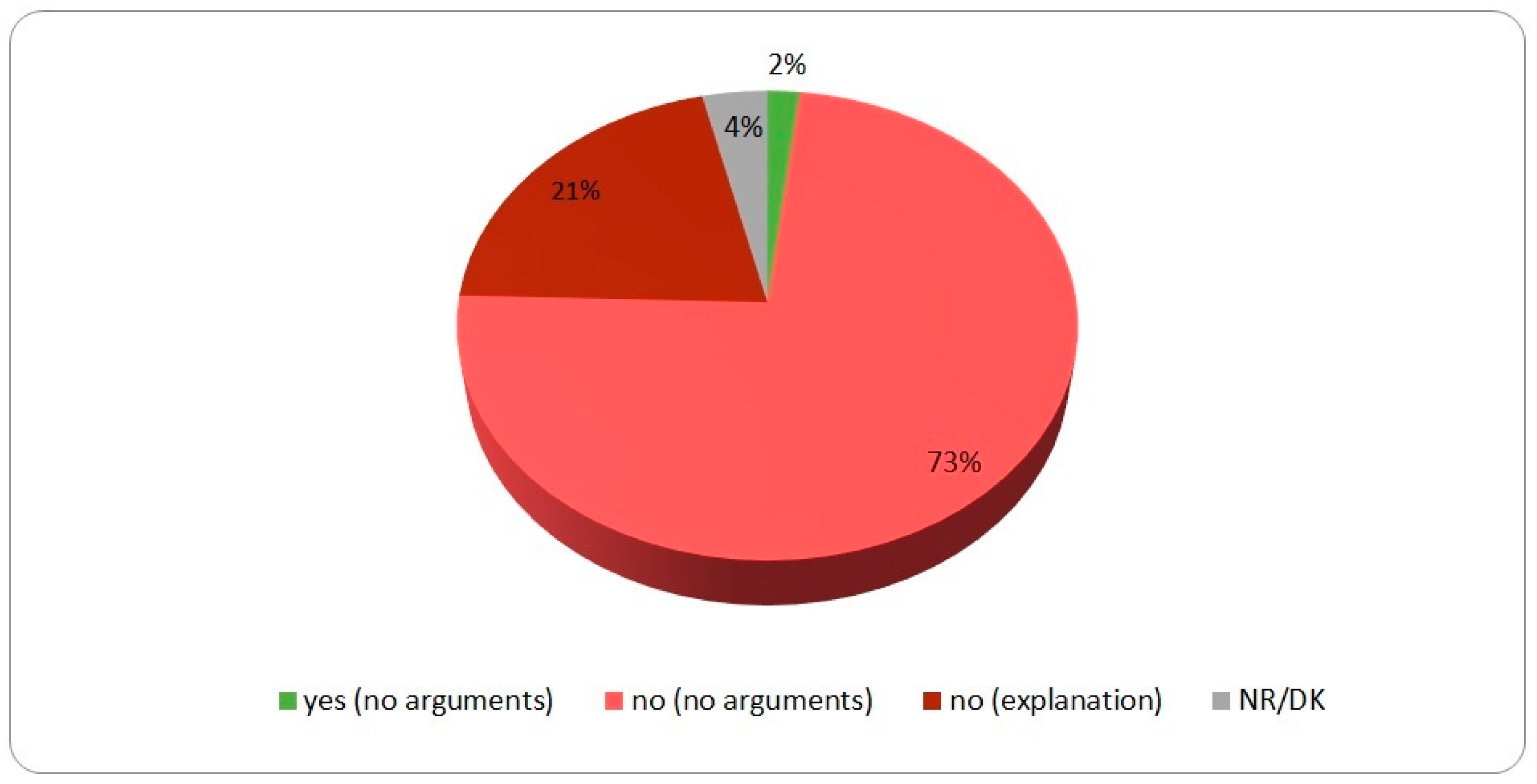
| Block Construct | Research Target | Item |
|---|---|---|
| (A) Personal information | Exploring the possible influence of socio-educational factors on the perception of landscape | Degree |
| Age | ||
| Place of residence | ||
| Place of birth | ||
| Gender | ||
| Geography as optional subject in secondary school | ||
| (B) Knowledge | Determining scientific and institutional understanding of landscape | Definition of landscape |
| Knowledge of the ELC | ||
| Ratification by Spain | ||
| Protected landscapes | ||
| Landscape-related legislation | ||
| (C) Experience | Understanding the landscape education received during pre-university studies | Landscape in ESO * |
| How landscape was addressed in ESO * | ||
| Landscape in BACH ** | ||
| How landscape in was addressed in BACH ** | ||
| (D) Critical reflection | Establishing the personal critical relationship with landscape | Living in the landscape |
| Being an agent of landscape | ||
| Quality of landscape | ||
| Landscape or territory |
| Blocks | Adequacy | Relevance | ||
|---|---|---|---|---|
| Average | SD | Average | SD | |
| (A) Personal information | 4.7 | 0.6 | 4.6 | 0.8 |
| (B) Knowledge | 4.7 | 0.6 | 4.8 | 0.4 |
| (C) Experience | 4.6 | 0.5 | 4.9 | 0.3 |
| (D) Critical reflection | 5.0 | 0.0 | 5.0 | 0.0 |
| Global average | 4.7 | 0.5 | 4.8 | 0.5 |
| Ages | Gender | Relationship Birth–Residence | Groups | Place of Residence | Place of Birth | Has Studied Geography in Non-Compulsory Secondary School | |||||||
|---|---|---|---|---|---|---|---|---|---|---|---|---|---|
| <20 | 51.2 | Man | 22.4 | Always rural | 7.1 | Conventional | 82.0 | Rural | 21.4 | Rural | 11.5 | Yes | 40.4 |
| 20–24 | 42.9 | Woman | 77.6 | Urban to rural | 14.3 | Double or Bilingual Degree | 18.0 | Urban | 78.6 | Urban | 88.5 | No | 58.7 |
| 25–29 | 3.4 | Always urban | 74.2 | No response | 0.9 | ||||||||
| 30–34 | 1.2 | Rural to urban | 4.3 | ||||||||||
| >34 | 1.2 | ||||||||||||
| Block | Item | Variable | Categories | Justification |
|---|---|---|---|---|
| (A) Personal information | Degree | Type of degree | Re-categorised into Degree/Double or bilingual degree | Indirect measure of pre-university academic level, because double and bilingual degrees demand a high entry mark. The aim is to establish if academic achievement affects perception of landscape |
| Age | Age groups | Re-categorised into <20/20–24/25–29/29–34/>34 | Conversion into a qualitative variable to facilitate statistical analysis. We created 5-year age groups, as these can mark significant periods in life | |
| Place of residence | Place of residence | Re-categorised into Rural/Urban | The aim is to establish if degrees of daily contact with the natural environment, more typical of rural environments (at any point in life) affect the perception of landscape | |
| Place of birth | Place of birth | Re-categorised into Rural/Urban | ||
| Relationship birth/residence | Re-categorised into Always rural/Urban to rural/Always urban/Rural to Urban | |||
| Gender | Gender | Woman/Man | The aim is to establish possible gender differences | |
| Geography as optional subject in BACH | Geography as optional subject in BACH | Yes/No/NR | The aim is to establish if greater explicit presence in the curriculum affects the perception of landscape | |
| (B) Knowledge | Definition of landscape | Fitness of definition | Re-categorised into Full/Partial/Wrong/NR | ELC’s definition used for reference, systematised in the ideas of perception of the environment (e.g., beauty, interpretation, sensations…), location of what is perceived (space, territory, place, site), and recognition of interaction between territorial elements: area, as perceived by people, whose character is the result of the action and interaction of natural and/or human factors. Mention of all three ideas is regarded as full definition; mentioning at least one as partial definition; not mentioning any as wrong definition |
| Presence of the perception component in the definition | Re-categorised into Yes/No/NR | |||
| Presence of the location component in the definition | ||||
| Presence of the territorial components in the definition | ||||
| Specification of territorial elements in the definition | Re-categorised into elements: Territorial (undefined)/Physical (only)/Physical and human (without interaction)/Physical and human (with interaction)/None | Distinction is made between physical elements (plants, climate, relief, fauna) and human elements (buildings, infrastructures) and whether interaction is alluded to in order to establish the alleged environmentalist approach suggested by the literature | ||
| Knowledge of the ELC | Knowledge of the ELC | Re-categorised into Yes/No/DK-NR | Any mention of the ELC is regarded as a “Yes” answer | |
| Ratification by Spain | Ratification by Spain | Yes/No/DK-NR | Any mention, regardless of content, is regarded as a “yes” answer | |
| Landscape legislation | Existence of protected landscapes | Re-categorised into Yes/Yes (example)/No/DK-NR | Two affirmative categories are included to distinguish between simple “Yes” answers and those who mention examples | |
| Types of protected landscapes | Re-categorised into Mountain/Water/Coastal | Examples of (alleged) national landscape cites are counted, as a projection of prevailing ideas on protected landscapes in a shared territory | ||
| Examples of protected landscapes | Homogenisation of mentioned names | |||
| Landscape legislation | Landscape legislation | Re-categorised into Yes/No/DK-NR | Any mention, regardless of content, is regarded as a “yes” answer | |
| (C) Experience | Landscape in ESO | Presence of landscape in ESO | Re-categorised into Yes/No/DK-NR | Any mention, regardless of content, is regarded as a “yes” answer |
| How landscape was addressed in ESO | Approach to landscape education in ESO | Re-categorised into Theoretical/Practical/DK-NR | Descriptions of the approaches adopted for their landscape education are distinguished by approach (theoretical/practical), didactic methods (master classes, commentary of images, debates), and resources (textbooks, videos, maps), as a reflection of the approximation to landscape in formal education | |
| Methodology of landscape education in ESO | Re-categorised into Oral activities/Written exercises/Class trips/Master classes | |||
| Resources for landscape education in ESO | Re-categorised into Interactive/Maps/Written/Visual | |||
| Landscape in BACH | Presence of landscape in BACH | Same as in ESO | ||
| How landscape was addressed in BACH | Approach to landscape education in BACH | |||
| Methodology of landscape education in BACH | ||||
| Resources for landscape education in BACH | ||||
| (D) Critical reflection | Living in landscape | Living in landscape | Re-categorised into Yes (without details)/Yes (urban)/Yes (rural)/No/DK-NR | “Yes” answers are divided into rural/urban to denote more detailed answers |
| Agent of landscape | Agent of landscape | Re-categorised into Yes (without details)/Yes (individual outlook)/Yes (collective outlook)/Yes (educational outlook)/No/NR | “Yes” answers are divided into different outlooks: personal (individual actions), collective (social action), and educational (teaching duties) | |
| Quality of landscape | Quality of landscape | Re-categorised into Yes (without details)/Yes (aesthetic considerations)/Yes (space for everyday life)/Yes (natural/human resources)/No/NR | “Yes” answers that provided more detail are divided into categorisations of landscape in terms of aesthetic perception, as the locus of everyday life, and in terms of resources | |
| Landscape or territory | Landscape = territory | Re-categorised into Yes (without details)/No (without details)/No (with explanation)/DK-NR | As the “No” answer is correct, those who gave some explanation, even if cursory, are highlighted | |
Disclaimer/Publisher’s Note: The statements, opinions and data contained in all publications are solely those of the individual author(s) and contributor(s) and not of MDPI and/or the editor(s). MDPI and/or the editor(s) disclaim responsibility for any injury to people or property resulting from any ideas, methods, instructions or products referred to in the content. |
© 2023 by the authors. Licensee MDPI, Basel, Switzerland. This article is an open access article distributed under the terms and conditions of the Creative Commons Attribution (CC BY) license (https://creativecommons.org/licenses/by/4.0/).
Share and Cite
Crespo Castellanos, J.M.; Martínez-Hernández, C.; Mateo Girona, M.R.; Rodríguez de Castro, A. Landscape Education Two Decades after the European Landscape Convention—A Study with Trainee Teachers. Educ. Sci. 2023, 13, 1188. https://doi.org/10.3390/educsci13121188
Crespo Castellanos JM, Martínez-Hernández C, Mateo Girona MR, Rodríguez de Castro A. Landscape Education Two Decades after the European Landscape Convention—A Study with Trainee Teachers. Education Sciences. 2023; 13(12):1188. https://doi.org/10.3390/educsci13121188
Chicago/Turabian StyleCrespo Castellanos, José Manuel, Carlos Martínez-Hernández, María Rosa Mateo Girona, and Ayar Rodríguez de Castro. 2023. "Landscape Education Two Decades after the European Landscape Convention—A Study with Trainee Teachers" Education Sciences 13, no. 12: 1188. https://doi.org/10.3390/educsci13121188
APA StyleCrespo Castellanos, J. M., Martínez-Hernández, C., Mateo Girona, M. R., & Rodríguez de Castro, A. (2023). Landscape Education Two Decades after the European Landscape Convention—A Study with Trainee Teachers. Education Sciences, 13(12), 1188. https://doi.org/10.3390/educsci13121188







